Chen Shen
Improving Complex Reasoning with Dynamic Prompt Corruption: A soft prompt Optimization Approach
Mar 17, 2025Abstract:Prompt-tuning (PT) for large language models (LLMs) can facilitate the performance on various conventional NLP tasks with significantly fewer trainable parameters. However, our investigation reveals that PT provides limited improvement and may even degrade the primitive performance of LLMs on complex reasoning tasks. Such a phenomenon suggests that soft prompts can positively impact certain instances while negatively affecting others, particularly during the later phases of reasoning. To address these challenges, We first identify an information accumulation within the soft prompts. Through detailed analysis, we demonstrate that this phenomenon is often accompanied by erroneous information flow patterns in the deeper layers of the model, which ultimately lead to incorrect reasoning outcomes. we propose a novel method called \textbf{D}ynamic \textbf{P}rompt \textbf{C}orruption (DPC) to take better advantage of soft prompts in complex reasoning tasks, which dynamically adjusts the influence of soft prompts based on their impact on the reasoning process. Specifically, DPC consists of two stages: Dynamic Trigger and Dynamic Corruption. First, Dynamic Trigger measures the impact of soft prompts, identifying whether beneficial or detrimental. Then, Dynamic Corruption mitigates the negative effects of soft prompts by selectively masking key tokens that interfere with the reasoning process. We validate the proposed approach through extensive experiments on various LLMs and reasoning tasks, including GSM8K, MATH, and AQuA. Experimental results demonstrate that DPC can consistently enhance the performance of PT, achieving 4\%-8\% accuracy gains compared to vanilla prompt tuning, highlighting the effectiveness of our approach and its potential to enhance complex reasoning in LLMs.
Don't Take Things Out of Context: Attention Intervention for Enhancing Chain-of-Thought Reasoning in Large Language Models
Mar 14, 2025Abstract:Few-shot Chain-of-Thought (CoT) significantly enhances the reasoning capabilities of large language models (LLMs), functioning as a whole to guide these models in generating reasoning steps toward final answers. However, we observe that isolated segments, words, or tokens within CoT demonstrations can unexpectedly disrupt the generation process of LLMs. The model may overly concentrate on certain local information present in the demonstration, introducing irrelevant noise into the reasoning process and potentially leading to incorrect answers. In this paper, we investigate the underlying mechanism of CoT through dynamically tracing and manipulating the inner workings of LLMs at each output step, which demonstrates that tokens exhibiting specific attention characteristics are more likely to induce the model to take things out of context; these tokens directly attend to the hidden states tied with prediction, without substantial integration of non-local information. Building upon these insights, we propose a Few-shot Attention Intervention method (FAI) that dynamically analyzes the attention patterns of demonstrations to accurately identify these tokens and subsequently make targeted adjustments to the attention weights to effectively suppress their distracting effect on LLMs. Comprehensive experiments across multiple benchmarks demonstrate consistent improvements over baseline methods, with a remarkable 5.91% improvement on the AQuA dataset, further highlighting the effectiveness of FAI.
A practical guide to machine learning interatomic potentials -- Status and future
Mar 12, 2025Abstract:The rapid development and large body of literature on machine learning interatomic potentials (MLIPs) can make it difficult to know how to proceed for researchers who are not experts but wish to use these tools. The spirit of this review is to help such researchers by serving as a practical, accessible guide to the state-of-the-art in MLIPs. This review paper covers a broad range of topics related to MLIPs, including (i) central aspects of how and why MLIPs are enablers of many exciting advancements in molecular modeling, (ii) the main underpinnings of different types of MLIPs, including their basic structure and formalism, (iii) the potentially transformative impact of universal MLIPs for both organic and inorganic systems, including an overview of the most recent advances, capabilities, downsides, and potential applications of this nascent class of MLIPs, (iv) a practical guide for estimating and understanding the execution speed of MLIPs, including guidance for users based on hardware availability, type of MLIP used, and prospective simulation size and time, (v) a manual for what MLIP a user should choose for a given application by considering hardware resources, speed requirements, energy and force accuracy requirements, as well as guidance for choosing pre-trained potentials or fitting a new potential from scratch, (vi) discussion around MLIP infrastructure, including sources of training data, pre-trained potentials, and hardware resources for training, (vii) summary of some key limitations of present MLIPs and current approaches to mitigate such limitations, including methods of including long-range interactions, handling magnetic systems, and treatment of excited states, and finally (viii) we finish with some more speculative thoughts on what the future holds for the development and application of MLIPs over the next 3-10+ years.
Federated Learning with Partially Labeled Data: A Conditional Distillation Approach
Dec 25, 2024



Abstract:In medical imaging, developing generalized segmentation models that can handle multiple organs and lesions is crucial. However, the scarcity of fully annotated datasets and strict privacy regulations present significant barriers to data sharing. Federated Learning (FL) allows decentralized model training, but existing FL methods often struggle with partial labeling, leading to model divergence and catastrophic forgetting. We propose ConDistFL, a novel FL framework incorporating conditional distillation to address these challenges. ConDistFL enables effective learning from partially labeled datasets, significantly improving segmentation accuracy across distributed and non-uniform datasets. In addition to its superior segmentation performance, ConDistFL maintains computational and communication efficiency, ensuring its scalability for real-world applications. Furthermore, ConDistFL demonstrates remarkable generalizability, significantly outperforming existing FL methods in out-of-federation tests, even adapting to unseen contrast phases (e.g., non-contrast CT images) in our experiments. Extensive evaluations on 3D CT and 2D chest X-ray datasets show that ConDistFL is an efficient, adaptable solution for collaborative medical image segmentation in privacy-constrained settings.
OpenAI o1 System Card
Dec 21, 2024



Abstract:The o1 model series is trained with large-scale reinforcement learning to reason using chain of thought. These advanced reasoning capabilities provide new avenues for improving the safety and robustness of our models. In particular, our models can reason about our safety policies in context when responding to potentially unsafe prompts, through deliberative alignment. This leads to state-of-the-art performance on certain benchmarks for risks such as generating illicit advice, choosing stereotyped responses, and succumbing to known jailbreaks. Training models to incorporate a chain of thought before answering has the potential to unlock substantial benefits, while also increasing potential risks that stem from heightened intelligence. Our results underscore the need for building robust alignment methods, extensively stress-testing their efficacy, and maintaining meticulous risk management protocols. This report outlines the safety work carried out for the OpenAI o1 and OpenAI o1-mini models, including safety evaluations, external red teaming, and Preparedness Framework evaluations.
Financial Risk Assessment via Long-term Payment Behavior Sequence Folding
Nov 22, 2024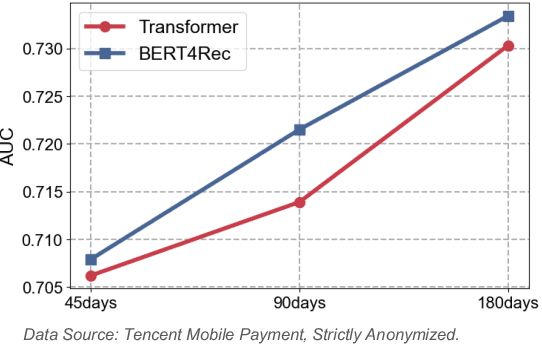
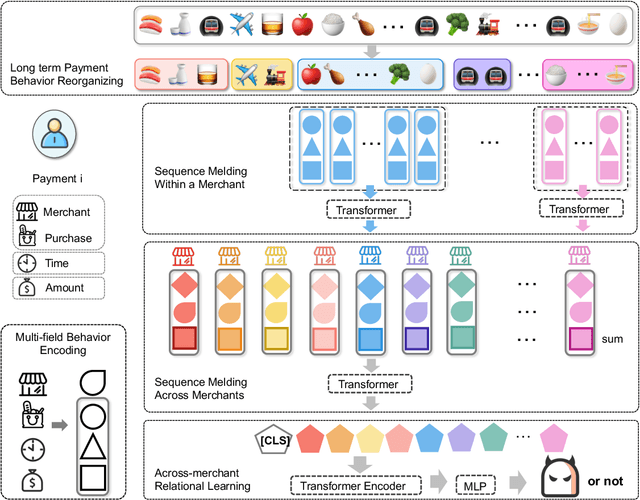
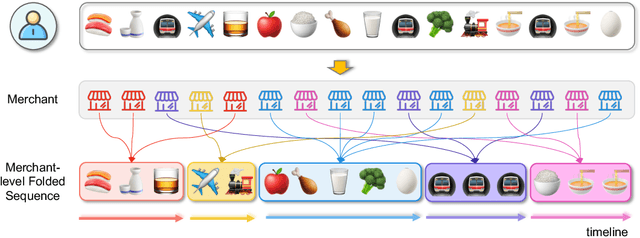
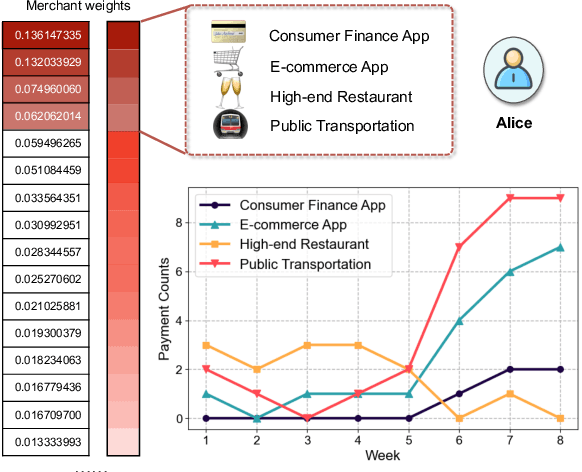
Abstract:Online inclusive financial services encounter significant financial risks due to their expansive user base and low default costs. By real-world practice, we reveal that utilizing longer-term user payment behaviors can enhance models' ability to forecast financial risks. However, learning long behavior sequences is non-trivial for deep sequential models. Additionally, the diverse fields of payment behaviors carry rich information, requiring thorough exploitation. These factors collectively complicate the task of long-term user behavior modeling. To tackle these challenges, we propose a Long-term Payment Behavior Sequence Folding method, referred to as LBSF. In LBSF, payment behavior sequences are folded based on merchants, using the merchant field as an intrinsic grouping criterion, which enables informative parallelism without reliance on external knowledge. Meanwhile, we maximize the utility of payment details through a multi-field behavior encoding mechanism. Subsequently, behavior aggregation at the merchant level followed by relational learning across merchants facilitates comprehensive user financial representation. We evaluate LBSF on the financial risk assessment task using a large-scale real-world dataset. The results demonstrate that folding long behavior sequences based on internal behavioral cues effectively models long-term patterns and changes, thereby generating more accurate user financial profiles for practical applications.
Seeing Clearly by Layer Two: Enhancing Attention Heads to Alleviate Hallucination in LVLMs
Nov 15, 2024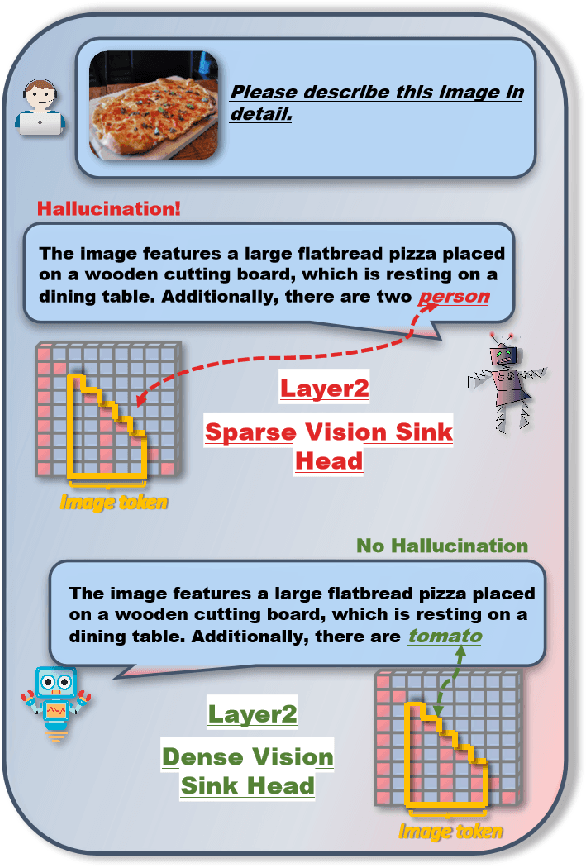
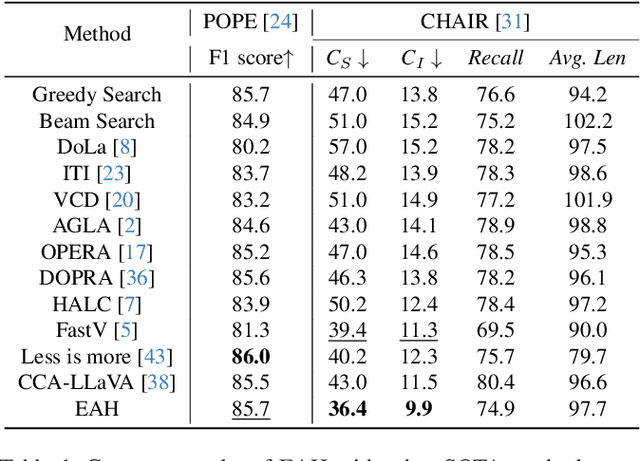
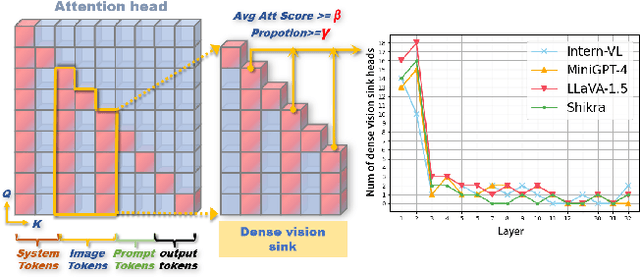
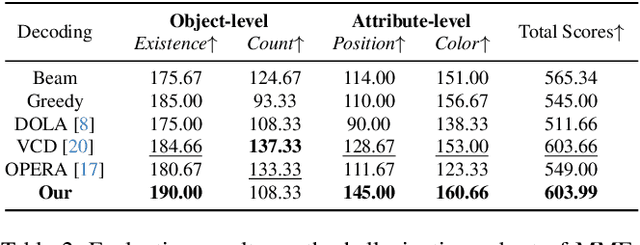
Abstract:The hallucination problem in multimodal large language models (MLLMs) remains a common issue. Although image tokens occupy a majority of the input sequence of MLLMs, there is limited research to explore the relationship between image tokens and hallucinations. In this paper, we analyze the distribution of attention scores for image tokens across each layer and head of the model, revealing an intriguing and common phenomenon: most hallucinations are closely linked to the pattern of attention sinks in the self-attention matrix of image tokens, where shallow layers exhibit dense attention sinks and deeper layers show sparse attention sinks. We further analyze the attention heads of different layers and find that heads with high-density attention sink in the image part play a positive role in alleviating hallucinations. In this paper, we propose a training-free method named \textcolor{red}{\textbf{E}}nhancing \textcolor{red}{\textbf{A}}ttention \textcolor{red}{\textbf{H}}eads (EAH), an approach designed to enhance the convergence of image tokens attention sinks in the shallow layers. EAH identifies the attention head that shows the vision sink in a shallow layer and extracts its attention matrix. This attention map is then broadcast to other heads in the layer, thereby strengthening the layer to pay more attention to the image itself. With extensive experiments, EAH shows significant hallucination-mitigating performance on different MLLMs and metrics, proving its effectiveness and generality.
SciPIP: An LLM-based Scientific Paper Idea Proposer
Oct 30, 2024



Abstract:The exponential growth of knowledge and the increasing complexity of interdisciplinary research pose significant challenges for researchers, including information overload and difficulties in exploring novel ideas. The advancements in large language models (LLMs), such as GPT-4, have shown great potential in enhancing idea proposals, but how to effectively utilize large models for reasonable idea proposal has not been thoroughly explored. This paper proposes a scientific paper idea proposer (SciPIP). Based on a user-provided research background, SciPIP retrieves helpful papers from a literature database while leveraging the capabilities of LLMs to generate more novel and feasible ideas. To this end, 1) we construct a literature retrieval database, extracting lots of papers' multi-dimension information for fast access. Then, a literature retrieval method based on semantics, entity, and citation co-occurrences is proposed to search relevant literature from multiple aspects based on the user-provided background. 2) After literature retrieval, we introduce dual-path idea proposal strategies, where one path infers solutions from the retrieved literature and the other path generates original ideas through model brainstorming. We then combine the two to achieve a good balance between feasibility and originality. Through extensive experiments on the natural language processing (NLP) field, we demonstrate that SciPIP can retrieve citations similar to those of existing top conference papers and generate many ideas consistent with them. Additionally, we evaluate the originality of other ideas generated by SciPIP using large language models, further validating the effectiveness of our proposed method. The code and the database are released at https://github.com/cheerss/SciPIP.
Instance-adaptive Zero-shot Chain-of-Thought Prompting
Sep 30, 2024



Abstract:Zero-shot Chain-of-Thought (CoT) prompting emerges as a simple and effective strategy for enhancing the performance of large language models (LLMs) in real-world reasoning tasks. Nonetheless, the efficacy of a singular, task-level prompt uniformly applied across the whole of instances is inherently limited since one prompt cannot be a good partner for all, a more appropriate approach should consider the interaction between the prompt and each instance meticulously. This work introduces an instance-adaptive prompting algorithm as an alternative zero-shot CoT reasoning scheme by adaptively differentiating good and bad prompts. Concretely, we first employ analysis on LLMs through the lens of information flow to detect the mechanism under zero-shot CoT reasoning, in which we discover that information flows from question to prompt and question to rationale jointly influence the reasoning results most. We notice that a better zero-shot CoT reasoning needs the prompt to obtain semantic information from the question then the rationale aggregates sufficient information from the question directly and via the prompt indirectly. On the contrary, lacking any of those would probably lead to a bad one. Stem from that, we further propose an instance-adaptive prompting strategy (IAP) for zero-shot CoT reasoning. Experiments conducted with LLaMA-2, LLaMA-3, and Qwen on math, logic, and commonsense reasoning tasks (e.g., GSM8K, MMLU, Causal Judgement) obtain consistent improvement, demonstrating that the instance-adaptive zero-shot CoT prompting performs better than other task-level methods with some curated prompts or sophisticated procedures, showing the significance of our findings in the zero-shot CoT reasoning mechanism.
NEST-RQ: Next Token Prediction for Speech Self-Supervised Pre-Training
Sep 13, 2024



Abstract:Speech self-supervised pre-training can effectively improve the performance of downstream tasks. However, previous self-supervised learning (SSL) methods for speech, such as HuBERT and BEST-RQ, focus on utilizing non-causal encoders with bidirectional context, and lack sufficient support for downstream streaming models. To address this issue, we introduce the next token prediction based speech pre-training method with random-projection quantizer (NEST-RQ). NEST-RQ employs causal encoders with only left context and uses next token prediction (NTP) as the training task. On the large-scale dataset, compared to BEST-RQ, the proposed NEST-RQ achieves comparable performance on non-streaming automatic speech recognition (ASR) and better performance on streaming ASR. We also conduct analytical experiments in terms of the future context size of streaming ASR, the codebook quality of SSL and the model size of the encoder. In summary, the paper demonstrates the feasibility of the NTP in speech SSL and provides empirical evidence and insights for speech SSL research.
 Add to Chrome
Add to Chrome Add to Firefox
Add to Firefox Add to Edge
Add to Edge